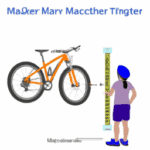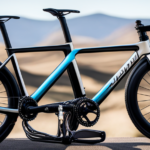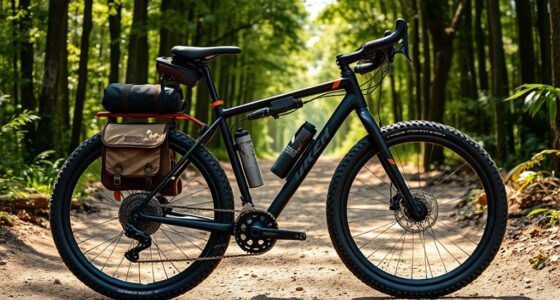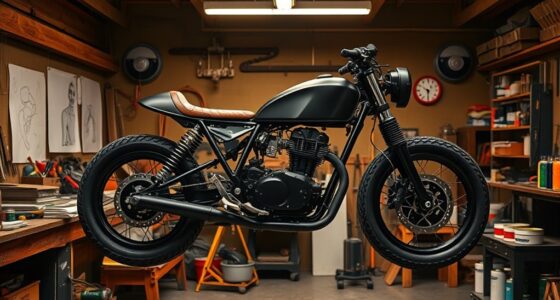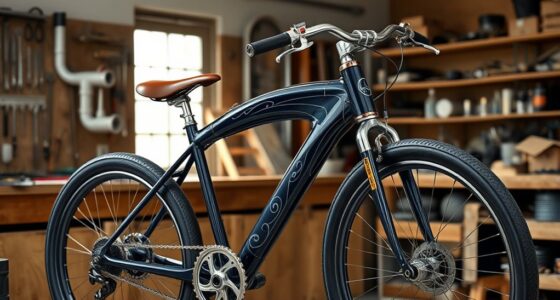To choose the right crank length, consider your body size, leg length, and riding style. Longer cranks give more leverage but may strain your joints, while shorter ones promote comfort and efficiency. Test different sizes to see what feels natural and minimizes joint stress, ensuring smooth pedal motion and ideal power transfer. Pay attention to how your body feels during and after rides—if you’re curious about fine-tuning your setup, there’s more to explore.
Key Takeaways
- Match crank length to your leg length and body proportions for optimal comfort and efficiency.
- Consider your riding discipline and goals, such as racing or mountain biking, when selecting crank size.
- Test different crank lengths to find the one that maintains natural knee bend and reduces joint strain.
- Longer cranks increase leverage but may cause joint stress; shorter cranks improve ergonomics and reduce overextension.
- Prioritize a fit where pedaling feels smooth, joints stay comfortable, and power transfer is maximized.
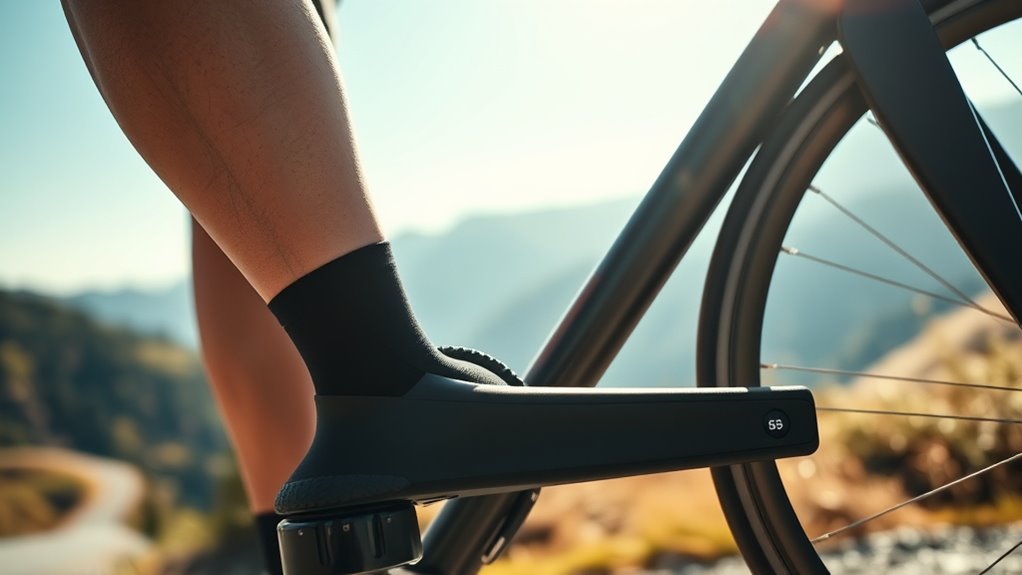
Selecting the right crank length is essential for optimizing your cycling comfort and efficiency. When you choose a crank length that suits your body and riding style, you’ll notice improvements in ergonomic benefits and pedal stroke efficiency. The right length supports proper joint alignment, reducing strain on your knees, hips, and ankles, which means you can ride longer and with less discomfort. It also encourages a more natural pedal motion, allowing your muscles to work together smoothly rather than fighting against awkward angles.
Choosing the right crank length enhances comfort, efficiency, and smooth pedal motion for a better ride experience.
Your body size, leg length, and riding discipline all influence the ideal crank length. If you have longer legs, a longer crank might give you more leverage and power, but it can also increase joint stress if too long. Conversely, shorter cranks tend to promote a better ergonomic fit for riders with shorter legs, helping prevent overextension and maintaining a comfortable knee bend during each pedal stroke. By selecting a crank length that aligns with your body proportions, you enhance pedal stroke efficiency. This means you generate power more effectively, with less wasted movement or unnecessary joint strain, leading to a more consistent and sustainable cycling rhythm.
The importance of pedal stroke efficiency cannot be overstated; it’s the foundation of effective energy transfer and endurance. When your crank length matches your biomechanics, your muscles work more harmoniously. This results in smoother pedal motion, less fatigue, and improved power output. A good fit also minimizes the risk of injury by reducing unnatural knee or hip angles that can develop over time with improper crank sizes.
Choosing the right crank length isn’t just about comfort; it’s about optimizing your entire riding experience. Consider how you want to use your bike—if you’re into racing, a slightly shorter crank might improve responsiveness and reduce fatigue over long distances. If you’re mountain biking, a length that provides better leverage and control might be preferable. Always test different sizes if possible, and pay attention to how your body feels during and after rides. Remember, the goal is to find a balance where your joints stay comfortable, your pedal stroke feels natural, and your power transfer is maximized.
Frequently Asked Questions
How Does Crank Length Affect Pedaling Efficiency?
Crank length directly impacts your pedaling efficiency by affecting your biomechanics and ergonomics considerations. Longer cranks can provide more leverage, potentially increasing power, but might cause discomfort or strain if they’re too long for your leg length. Shorter cranks promote a smoother pedal stroke and reduce joint stress. Customizing crank length guarantees the best efficiency, comfort, and injury prevention, so you should select a size that matches your leg length and riding style.
Can Changing Crank Length Improve Cycling Performance?
Changing crank length can boost your cycling performance by optimizing your pedaling biomechanics, debunking common crank length myths. Studies show that riders with properly fitted cranks pedal more efficiently, reducing fatigue and increasing power output. By selecting the right crank length, you align your body movements better, leading to smoother rides and improved endurance. Don’t rely on myths—understand your biomechanics and tailor your gear for peak performance.
Is There an Ideal Crank Length for Sprinting Versus Climbing?
For sprinting, opt for a shorter crank length to maximize power transfer and bike frame compatibility, helping you accelerate quickly. When climbing, a slightly longer crank can give you more leverage, but always consider pedal size considerations to guarantee comfort and efficiency. Your ideal crank length depends on your riding style, body dimensions, and bike setup, so test different sizes to find what boosts your performance without compromising comfort.
How Do I Measure My Optimal Crank Length Accurately?
Think of finding your ideal crank length as tuning a musical instrument. To measure accurately, you’ll want to take ergonomics considerations into account and perform bike fit adjustments, ensuring your crank arms match your leg length and riding style. Use a ruler or specialized tools to measure your inseam, then compare it to manufacturer recommendations. Testing different lengths on your bike can help you feel which setup offers the greatest comfort and efficiency.
Does Crank Length Influence Knee or Joint Health?
Yes, crank length can influence joint strain and injury prevention. A crank that’s too long may cause you to extend your knee excessively, increasing stress on your joints and raising injury risk. Conversely, a properly matched crank length allows for smoother pedaling, reducing joint strain and helping you avoid overuse injuries. Selecting the right crank length is essential for protecting your knees and maintaining healthy joints during rides.
Conclusion
Choosing the right crank length is like finding the perfect pair of shoes—you’ll feel more comfortable and confident on every ride. I once swapped to a shorter crank and instantly noticed less knee pain, making my rides smoother and more enjoyable. Remember, just like shoes, the right crank length supports you best when it fits your body. Trust your instincts and test different sizes—your perfect match is out there, waiting to make every pedal stroke feel effortless.





